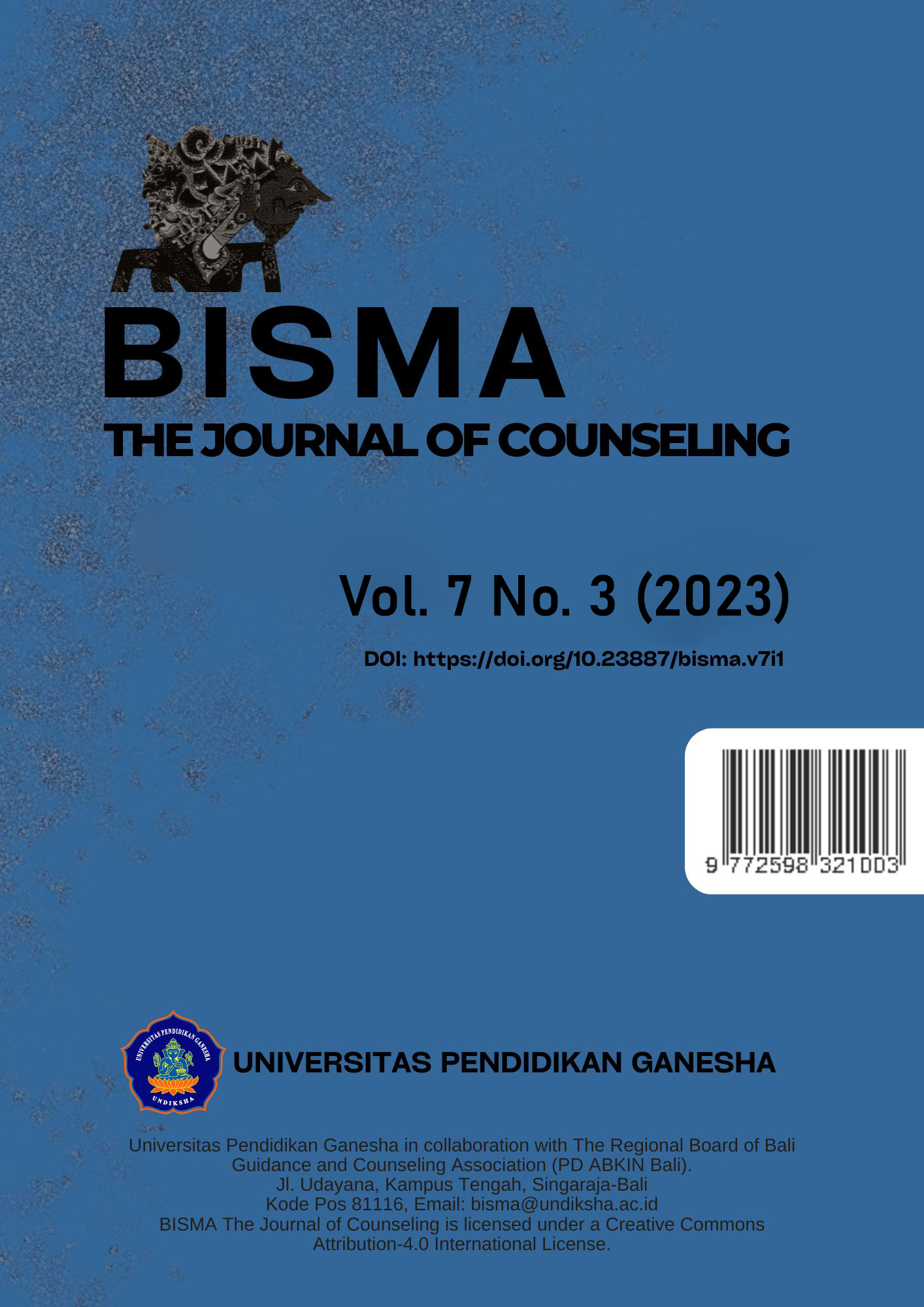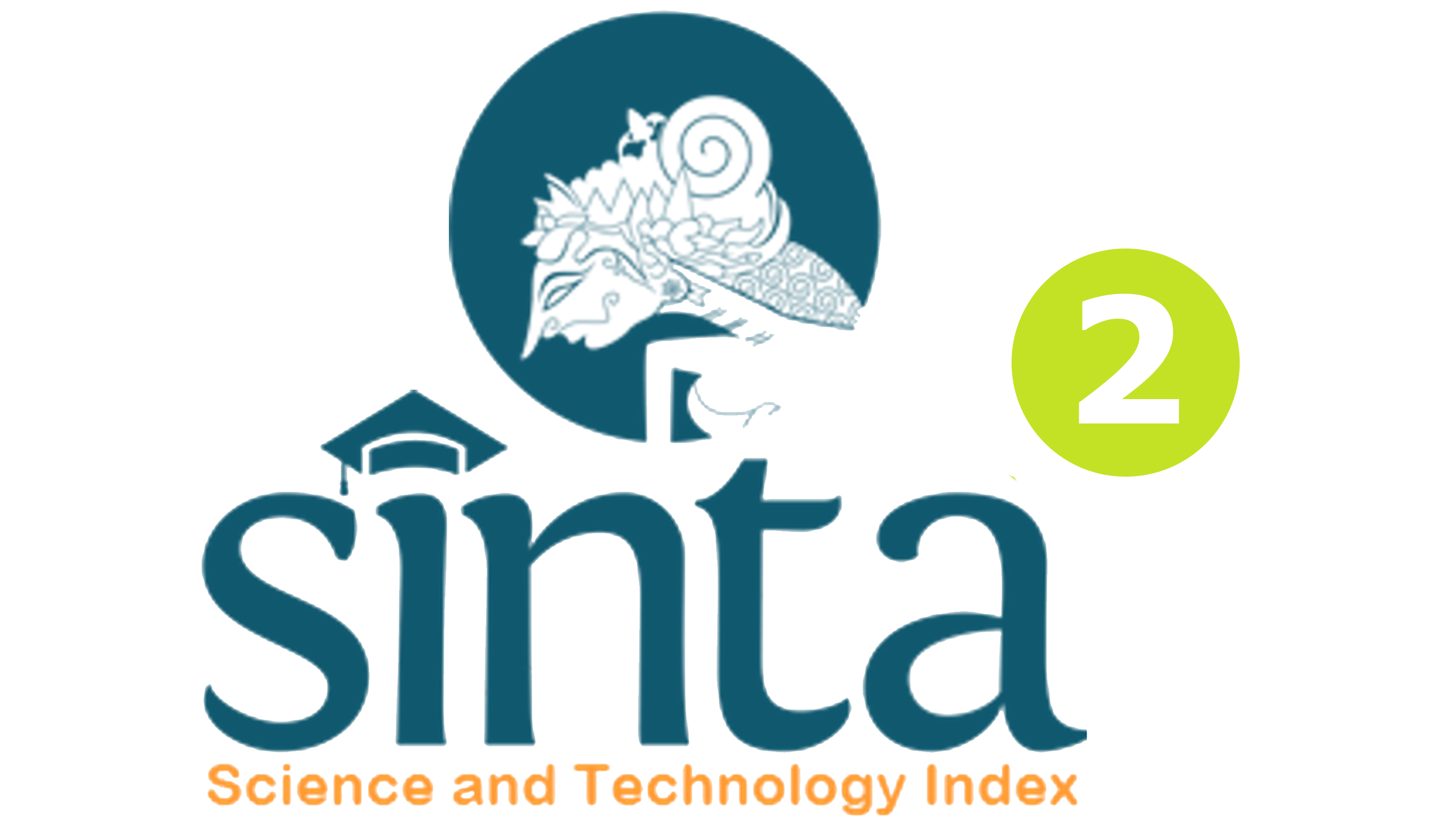Attachment Styles and Parasocial Relationships among K-Pop Fans in Indonesia
DOI:
https://doi.org/10.23887/bisma.v7i3.70440Keywords:
attachment styles, secure attachment style, fearful attachment style, preoccupied attachment style, dismissing attachment style, parasocial relationshipsAbstract
The Korean Pop phenomenon that is currently happening all over the world including Indonesia has created a new culture among its fans, a culture of building parasocial relationships with their idols. Parasocial relationships that are illusory and one-sided relationships from the fan side only, could be influenced by the fans’ attachment style. This study aims to analyze the relationships between the 4 types of attachment styles: secure attachment style, fearful attachment style, preoccupied attachment style, and dismissing attachment style according to Bartholomew and Horowitz (1991) with parasocial relationships among K-Pop fans in Indonesia. Samples in this study were 378 K-Pop fans from all over Indonesia who were taken with purposive sampling technique. Attachment Style Questionnaire (ASQ) by Oudenhoven, Hofstra, and Bakker (2003) which has been adapted to Indonesian by Fitriana and Fitria (2016) were used as the tool to measure the attachment styles. Meanwhile, parasocial relationships were measured using the Multidimensional Measure of Parasocial Relationships to a K-Pop Idol (MMPR-K-Pop) developed by Garcia, Bjork, and Kazemitabar (2022). The results of this study showed that there are positive correlations between fearful attachment style (r = 0,344; p<0,05) and parasocial relationships and also between preoccupied attachment style and parasocial relationships (r = 0,130, p<0,05), while there are negative correlations between secure attachment style and parasocial relationship (r = -0,150; p<0,05) and also between dismissing attachment style and parasocial relationships (r = -0,157; p<0,05).
References
Acar, E. (2011). Effects of social capital on academic success: A narrative synthesis. Educational Research and Reviews, 6(6), 456–461. https://www.researchgate.net/profile/Ali-Rahimi-14/post/Can-anyone-point-me-to-critical-literature-examining-the-role-of-social-capital-in-education/attachment/59d61ddd79197b807797b3fc/AS%3A273754758811650%401442279628301/download/social+capital+5.pdf.
Aldabbus, S. (2018). Project-Based Learning: Implementation & Challenges. International Journal of Education, Learning and Development, 6(3), 71–79. https://www.researchgate.net/profile/Shaban-Aldabbus/project/BTC-candidate-teachers-opinion-of-project-based-learning/attachment/5b8d7e7e3843b0067537935f/AS:666844868403200@1535999614238/download/Project-Based-Learning-Implementation-Challenges.pdf.
Allison, S. Z. (2023). Islamic Educational Provisions in South Korea and Indonesia: A Comparison. Journal of Islamic Education Students, 3(1), 50–61. https://doi.org/10.31958/jies.v3i1.8772.
Andina, A. N. (2019). Hedonisme Berbalut Cinta Dalam Musik K-Pop. Syntax Idea, 1(8), 39–49. http://eprints.unm.ac.id/11166/.
Antee, A. (2021). Student perceptions and mobile technology adoption: implications for lower-income students shifting to digital. Educational Technology Research and Development, 69(1), 191–194. https://doi.org/10.1007/s11423-020-09855-5.
Ardhiyansyah, A., Maharani, D. P., Sari, S. P., & Mansur, U. (2021). K-Pop Marketing Tactics That Build Fanatical Behavior. 1st ICEMAC 2020: International Conference on Economics, Management, and Accounting, 4(4), 66–70. https://doi.org/10.11594/nstp.2021.1007.
Choi, S., Seo, H. J., & Kim, Y. S. (2016). Analysis of the Research Trends of the Korean Journal of Educational Research Using Network Text Analysis. International Journal of Software Engineering and Its Applications, 10, 169–178. https://www.earticle.net/Article/A297547.
Darner, R. (2014). Influences on students’ environmental self determination and implications for science curricula. International Journal of Environmental and Science Education, 9(1), 21–39. https://doi.org/10.12973/ijese.2014.201a.
Deichmann, F., & Ahnert, L. (2021). The Terrible Twos: How Children Cope With Frustration And Tantrums And The Effect Of Maternal And Paternal Behaviors. Infancy, 26(3), 469–493. https://doi.org/10.1111/infa.12389.
Espericueta-Medina, M. N., Sánchez-Rivera, L., Villarreal-Soto, B. M., & Ramírez-Padrón, M. Y. (2020). The importance of Self-efficacy and Resilience in the Learning Style of the University Student. ECORFAN Journal Republic of Paraguay, December 2021, 6–14. https://doi.org/10.35429/ejrop.2020.11.6.6.14.
Fahri, L. M., & Qusyairi, L. A. H. (2019). Interaksi Sosial dalam Proses Pembelajaran. Palapa, 7(1), 149–166. https://doi.org/10.36088/palapa.v7i1.194.
Fauzi, F. I., & Tarigan, F. N. (2023). Strawberry generation: keterampilan orangtua mendidik generasi Z. Jurnal Consulenza : Jurnal Bimbingan Konseling Dan Psikologi, 6(1), 1–10. https://doi.org/10.56013/jcbkp.v6i1.2047.
Garza, A. de la, & Travis, C. (2019). The STEAM Revolution. In The STEAM Revolution. https://doi.org/10.1007/978-3-319-89818-6.
Heong, Y. M., Hamdan, N., Ching, K. B., Kiong, T. T., & Azid, N. (2020). Development of integrated creative and critical thinking module in problem-based learning to solve problems. International Journal of Scientific and Technology Research, 9(3), 6567–6571.
Hoskin, E. R., Coyne, M. K., White, M. J., Dobri, S. C. D., Davies, T. C., & Pinder, S. D. (2022). Effectiveness of technology for braille literacy education for children: a systematic review. Disability and Rehabilitation: Assistive Technology, 2(1), 1–11. https://doi.org/10.1080/17483107.2022.2070676.
Jothi, N., & Chanthiramathi, V. (2019). A theoretical critique of J.K. Rowling’s Harry Potter series. International Journal of Recent Technology and Engineering, 8(3 Special Issue), 526–532. https://doi.org/10.35940/ijrte.C1109.1083S19.
Khikmah, N. (2020). Manajemen Sarana Dan Prasarana Untuk Mengembangkan Mutu Pendidikan. Jurnal Administrasi Dan Manajemen Pendidikan, 3, 123–130. https://doi.org/10.17977/um027v3i22020p123.
Kumala, E. F., Widodo, J., & Zulianto, M. (2022). The Effect Of Using The K-Pop Idol Ambassador Brand And Company Brand Image On Purchase Decisions On The Marketplace Shopee. Profitability, 6(1), 1–5.
Larasati, T. A., Amalia, N. R., & Mawardani, M. (2022). Pengaruh Idol Kpop Sebagai Brand Ambassador, Brand Image Dan Brand Awareness terhadap Keputusan Pembelian Mie Lemonilo. SOLUSI: Jurnal Ilmiah Bidang Ilmu Ekonomi, 20(4), 403–413. https://doi.org/10.26623/slsi.v20i4.6069.
Li, Y. (2022). Analysis of Psychological Disorders and Adaptive Influence of Blended Learning of College Students. Computational Intelligence and Neuroscience, 1–12. https://doi.org/10.1155/2022/5418738.
Maas, M. K., Gal, T., Cary, K. M., & Greer, K. (2022). Popular culture and pornography education to improve the efficacy of secondary school staff response to student sexual harassment. American Journal of Sexuality Education, 17(4), 435–457. https://doi.org/10.1080/15546128.2022.2076757.
McLean, K., Edwards, S., Evangelou, M., & Lambert, P. (2018). Supported playgroups in schools: bonding and bridging family knowledge about transition to formal schooling. Cambridge Journal of Education, 48(2), 157–175. https://doi.org/10.1080/0305764X.2016.1268569.
Moreira, H., Joao, G. M., & Cristina, C. M. (2018). Is Mindful Parenting Associated with Adolescents’ Well-being in Early and Middle/Late Adolescence? The Mediating Role of Adolescents’ Attachment Representations, Self-Compassion and Mindfulness. Journal of Youth and Adolescence, 47(8), 1771–1788. https://doi.org/10.1007/s10964-018-0808-7.
Oh, H., Sutherland, M., Stack, N., Badia Martín, M., Blumen, S., Nguyen, Q. A. T., Wormald, C., Maakrun, J., & Ziegler, A. (2019). Adolescent Perception of Potential High-Performing Classmates: Across-National Exploration. Roeper Review, 41(2), 88–101. https://doi.org/https://doi.org/10.1080/02783193.2019.1585398.
Park, S., Ryu, J., & McChesney, K. (2019). Collaborative studio experiences between South Korean and American pre-service teachers: A case study of designing culturally-responsive virtual classroom simulation. TechTrends, 63(3), 271–283. https://doi.org/10.1007/s11528-019-00392-4.
Park, J. S., Bae, J. H., & Cho, K. S. (2015). Emotional responses to e-magazine published with cinemagraph images. Agribusiness and Information Management, 7(1), 10–20. https://scholar.archive.org/work/ki4757sjojhgxm6g5vrho7xoti/access/wayback/http://aimjournal.net/wp-content/themes/aim/download.php?type=article&article_id=199&attachment_id=200.
Perdana, A. P., & Kartidjo, W. (2022). Place Attachment Study in Chinatown (Case Study: Pancoran Glodok Chinatown and Pantjoran PIK Chinatown). In ITB Graduate School Conference, 2(1), 217–231. https://gcs.itb.ac.id/proceeding-igsc/index.php/igsc/article/view/85.
Rini, D. S., Adisyahputra, & Sigit, D. V. (2020). Boosting student critical thinking ability through project based learning, motivation and visual, auditory, kinesthetic learning style: A study on Ecosystem Topic. Universal Journal of Educational Research, 8(4A), 37–44. https://doi.org/10.13189/ujer.2020.081806.
Saarni, C. (2014). Emotion regulation and personality development in childhood. In Handbook of Personality Development. https://doi.org/10.4324/9781315805610-21.
Santos, M., & Schlesinger, W. (2021). When love matters. Experience and brand love as antecedents of loyalty and willingness to pay a premium price in streaming services. Spanish Journal of Marketing - ESIC, 25(3), 374–391. https://doi.org/10.1108/SJME-11-2020-0201.
Schmid, H., & Klimmt, C. (2011). A magically nice guy: Parasocial relationships with Harry Potter across different cultures. International Communication Gazette, 73(3), 252–269. https://doi.org/10.1177/1748048510393658.
Setiati, G. (2015). Gender dan Place Attachment Pada Coffe Shop di Bandung (Studi Kasus Roemah Kopi). Jurnal Sosioteknologi, 14(3), 298–310. https://doi.org/10.5614/SOSTEK.ITBJ.2015.14.3.8.
Sugiyono. (2009). Motode Penlitian Kuantitatif, Kualitatif, dan R&D. CV. Alfabeta.
Sukamolson, S. (2007). Fundamentals of quantitative research. Language Institute Chulalongkorn University, 1(3), 1–20.
Susanto, H., Sasongko, R. N., & Kristiawan, M. (2021). Teachers ’Professionality in Improving the Quality of Madrasah Education in The Era of Globalization. Journal of Teacher Studies and Learning, 4(1), 135–141. https://doi.org/10.30605/jsgp.4.1.2021.551.
Suwanda, D. (2015). Factors affecting quality of local government financial statements to get unqualified opinion (WTP) of audit board of the Republic of Indonesia (BPK). Research Journal of Finance and Accounting, 6(4), 139–157.
Toraman, C. (2020). Relationships between Cognitive Flexibility, Perceived Quality of Faculty Life, Learning Approaches, and Academic Achievement. International Journal of Instruction, 13(1), 85–100. https://doi.org/https://doi.org/10.29333/iji.2020.1316a.
Wardhani, N. K., Widyorini, E., & Roswita, M. Y. (2022). Negative parenting dan Insecure attachment dengan perilaku disruptive pada remaja. Jurnal Psikologi, 18(1), 25. https://doi.org/10.24014/jp.v18i1.14585.
Westenberg, P., & Rutten, K. (2017). “Do You Speak My Neighbourhood?” Language, Technology, and Proximity. Critical Arts, 31(2). https://doi.org/10.1080/02560046.2017.1355399.
Winarno, A., Fedin, M. Y. A., & Salleh, N. H. M. (2022). the Effect of Technological Literacy, Learning Facility, and Family Environment on Students’ Learning Motivation. Jurnal Pendidikan: Teori, Penelitian, Dan Pengembangan, 7(7), 246. https://doi.org/10.17977/jptpp.v7i7.15404.
Wójcik, G., Zawisza, K., Jabłońska, K., Grodzicki, T., & Tobiasz-Adamczyk, B. (2021). Transition out of marriage and its effects on health and health–related quality of life among females and males. courage and courage-polfus–population based follow-up study in Poland. Applied Research in Quality of Life, 16, 13–49. https://doi.org/10.1007/s11482-019-09742-z.
Wu, F., Jiang, Y., Liu, D., Konorova, E., & Yang, X. (2022). The role of perceived teacher and peer relationships in adolescent students’ academic motivation and educational outcomes. Educational Psychology, 42(4), 439–458. https://doi.org/10.1080/01443410.2022.2042488.
Zhang, Y., Zhang, H. L., Zhang, J., & Cheng, S. (2014). Predicting residents’ pro-environmental behaviors at tourist sites: The role of awareness of disaster’s consequences, values, and place attachment. Journal of Environmental Psychology, 40, 131–146. https://doi.org/10.1016/j.jenvp.2014.06.001.
Zhu, D., Kim, P. B., Milne, S., & Park, I. J. (2021). A Meta-Analysis of the Antecedents of Career Commitment. Journal of Career Assessment, 29(3), 502–524. https://doi.org/10.1177/1069072720956983.
Downloads
Published
Issue
Section
License
Copyright (c) 2024 Abigail Firsta S Ni Putu, Ambarwati Krismi Diah

This work is licensed under a Creative Commons Attribution 4.0 International License.









